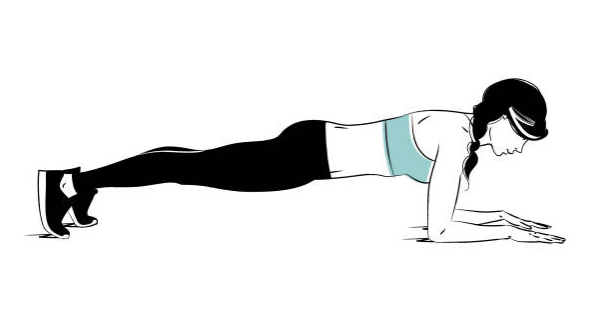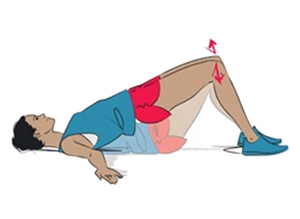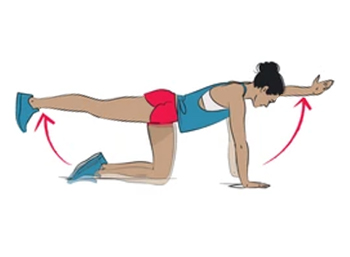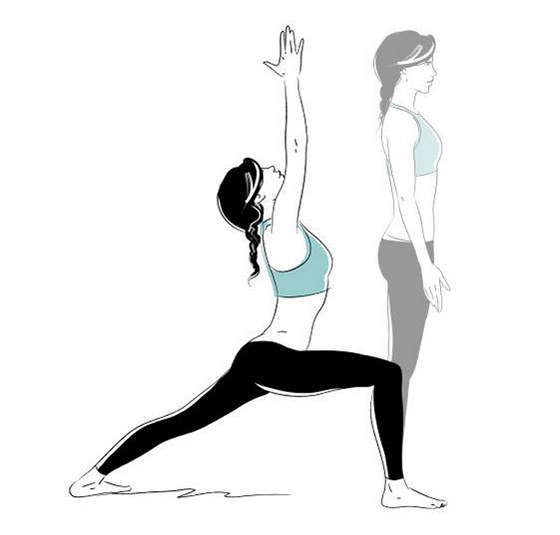According to the unbendable exercise law of specificity, the best way to get better at running is to run. You need to put in the miles if you want to improve your fitness for running and that means being consistent in your training.
Do distance work, speed work, hill work and intervals to ensure you develop all aspects of running fitness. Over a period of weeks of months, you should start to see your running performance improve.
However, there may also be something other than fitness preventing you from reaching your best running performances.
Muscle tightness, muscle weakness, core instability or poor running technique could all be conspiring to hold you back. Fix these problems by performing appropriate running-specific exercises and drills.
Strength Moves for Runners
1 Planks

Purpose: To strengthen the core
How to perform:
- Lie on your front and rest on your elbows with your hands clasped lightly together.
- Brace your abs as if you are about to get punched in the stomach and lift your hips off the floor so that your shoulders, hips and feet form a straight line.
- Look straight down at the floor. Hold this position (but not your breath!) for 30 to 60-seconds.
- Do two to four sets.
2 Supine Hip Bridges

Purpose: To increase glute, hamstring and lower back strength
How to perform:
- Lie on your back with your legs bent and feet flat on the floor. Place your hands on the floor next to your hips.
- Without using your arms for assistance, push your hips up toward the ceiling so that your weight is supported on your feet and shoulders only. Hold this top position for a count of two.
- Lower your butt back to the floor and repeat.
- Do two to four sets of 10 to 20-repetitions.
Variation: Rest and hold a weight across your hips or use one leg at a time for a more demanding workout.
3 Band-Resisted Squats
Purpose: To prevent inward knee roll (and therefore runner’s knee) by increasing hip stability and general leg strength
How to perform:
- Loop or tie a light resistance band around your knees and stand with your feet shoulder-width apart so that the band is tensioned. Keep your chest up, push your hips back and bend your knees.
- Squat down until your thighs are roughly parallel to the floor. Push your knees out against the resistance of the band at all times.
- Stand back up and repeat.
Variation: Add weight in the form of dumbbells or a barbell if required. Do two to four sets of 10 to 20-reps.
4 Bird Dogs

Purpose: To strengthen the lower back, core, glutes and upper back to increase running performance and reduce risk of injury
How to perform:
- Kneel on all fours with your hips directly over your knees and your shoulders directly over your hands.
- Keeping your neck neutral, extend your left arm and right leg as if you were trying to touch the wall directly in front and behind you. Keep your core tight and do not extend your lower back.
- Hold for a second and then lower your arm and leg back to the floor.
- Immediately perform another rep using the opposite limbs.
- Do two to four sets of six to ten-reps per side.
Drills for Runners
5 High Knees
Purpose: To develop greater knee lift and a more powerful running stride
How to perform:
- Run on the spot with your arms bent and forearms parallel to the floor.
- Without leaning forward or lowering your arms, bring your knees up to meet your outstretched hands.
- Continue for 30 to 60-seconds.
This exercise can be performed on the spot or while traveling forward and can also be done while marching rather than running if preferred.
6 Fast Feet
Purpose: To develop a faster running cadence
How to perform:
- Run on the spot and gradually increase the speed at which you pump your arms and legs.
- Keep your feet low to the ground and while endeavoring to touch the floor as lightly and quickly as possible; imagine the ground is red hot!
- Travel forwards trying to perform as many reps as you can over a given distance – e.g. ten-meters. Do not tense your arms, shoulders or neck.
- Rest a moment and then repeat for two to four sets.
7 Bounding
Purpose: To increase running power
How to perform:
- Start running normally but then, once you are into your stride, lengthen each step and attempt to cover as much ground per stride as possible – use your arms for extra momentum and drive hard off your rear leg.
- Do 10 to 20-bounds in total.
- Rest a moment and then do two to four more sets. Strive to cover the same of more distance set by set.
8 Butt Kicks
Purpose: To improve the recovery phase of running and teach hamstring engagement
How to perform:
- Run forward slowly (but with moderately fast feet) with your hands resting palms out against your buttocks.
- Pick your feet up and try to touch your butt with your heels. Do not lean forward.
- Perform this exercise for distance e.g. 20-meters or repetitions e.g. 20 on each leg.
Stretches for Runners
9 Runner’s Lunge

Purpose: To open up the hips and promote a longer stride
How to perform:
- Kneel down on the floor and then step forward so you are in a staggered lunge position.
- With your front shin vertical, slide your rear leg back until you feel a mild stretch in your hips. Keep your torso upright and hold this position for 30 to 60-seconds.
- Ease out of the stretch and then change legs.
Tip: Do not place your hands on your legs for support but, instead, let your arms hang down by your sides or clasp them behind your back. This will maximize the affect of gravity and ensure you get a deeper and more effective stretch.
10 Thoracic Release with Foam Roller
Purpose: To promote a more upright posture and reduce the potential for back pain
How to perform:
- Lie on your back with your legs bent and feet flat on the floor. Place a foam roller between your shoulders and the ground. Put your hands on your temples and lean back over the roller.
- Using your legs, push yourself over the roller so that is moves from behind your shoulders to your lower ribs; stay away from your lumbar spine.
- Roll up and down your thoracic spine five to ten times and then relax over your roller for 30 to 60-seconds.
Do not hold your breath when performing this exercise.
11 Assisted Hamstring Stretch
Purpose: To minimize risk of hamstring injury and promote a longer stride
How to perform:
- Sit on the floor with your legs extended in front of you. Loop a resistance band over one foot.
- Lean back and pull your leg upright – a slight bend in the knee is allowed.
- Gradually pull in on the band to increase the stretch. Hold for 30 to 60-seconds and then switch legs.
- If your hamstrings are especially tight, repeat the exercise once or twice more.
Daily hamstring stretches are an excellent idea for most runners.
12 Doorway Chest Stretch
Purpose: To open the chest and improve posture
How to perform:
- Stand in an open doorway and place your forearms on the side frames so your upper arms are parallel to the floor and your elbows are bent to 90-degrees.
- In a staggered stance, lean forward and push your chest gently between your arms.
- Hold for 30 to 60-seconds.
Plugging any technical or physical weaknesses will ensure you get the most distance and speed from your running energy expenditure. You may only get a small improvement in performance but when races can be won or lost by as little as a couple of seconds, even small advantages can be very valuable.

